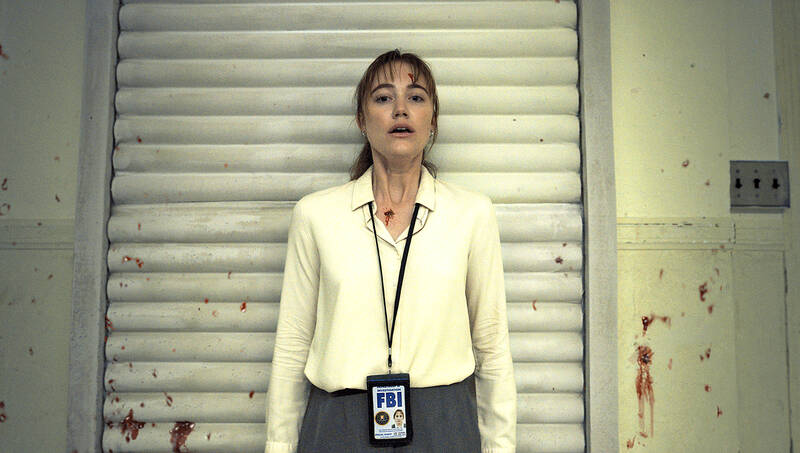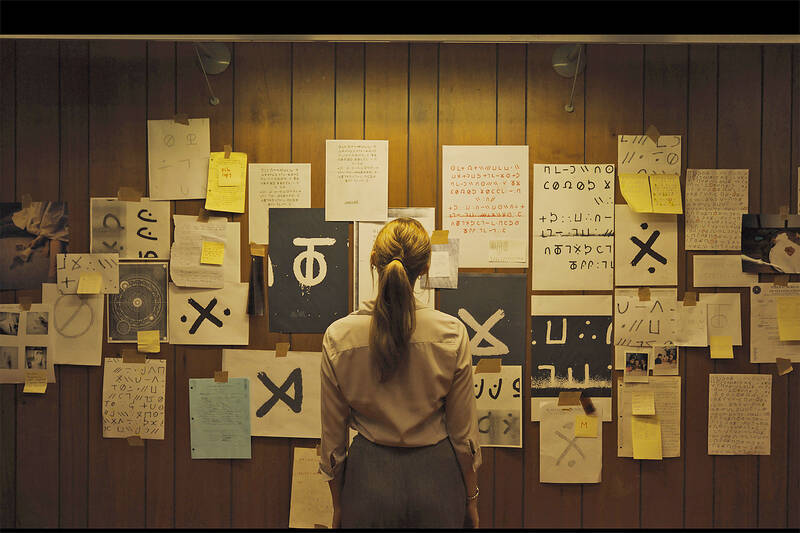Her FBI colleagues describe Agent Lee Harker (Maika Monroe) as “highly intuitive.” And if the term sounds like federal agency code for something ominous and slightly sinister, that’s because it is. Harker might lack social graces (she’d sooner lurk alone in her coffin-like, wood-lined cabin than engage in small talk), but she has uncanny instincts when reading a crime scene.
Or she does for some of the time, at least — it’s a gift that is selective and intermittent. But as jovial, gregarious Agent Carter (Blair Underwood) observes: “Half-psychic is better than not psychic at all.”
Carter is clearly the glass-half-full type, particularly if the glass is half full of whiskey. He has recruited Harker to work on a confounding cold case, hoping that her abilities may help to get the investigation moving again. What he couldn’t have anticipated is the fact that her presence acts as a catalyst, luring out the shadowy figure known as Longlegs (a thoroughly chilling Nicolas Cage) — a grotesque, glam rock-obsessed goblin of a man who is implicated in a series of mass murders that span decades.

Photo: AP
And so the scene is set for the buzzy latest film from Osgood Perkins (Gretel & Hansel, I Am the Pretty Thing That Lives in the House), a grimly atmospheric FBI procedural with occult overtones that has been declared, in some of the more excitable corners of the Internet, as the second coming of The Silence of the Lambs.
Of course, hype is the kind of spotlight that rarely flatters its subject, and these kinds of comparisons do the film no favors at all. Longlegs is not in the same league as Jonathan Demme’s masterpiece, or for that matter Seven, another frequent comparison. Among other things, the writing — specifically a crude chunk of third-act exposition — lets it down. But still, there is plenty to admire in this oppressively brooding and superbly acted chiller. To paraphrase Carter, perhaps half-great is better than not great at all.
One of the film’s most impressive assets is Monroe, who, having starred in It Follows and Watcher, is among the few actors who can match Mia Goth in the ranks of this generation’s finest genre performers. Harker is stonily antisocial with her colleagues, a woman most at ease in the murky reaches of her own mind. But she’s a gifted agent, blessed with the kind of unwavering focus that results from being far more at ease unpicking the ritualistic details of a serial killer’s modus operandi than you are going for drinks with your workmates.

Photo: AP
When Carter forces her to socialize, hauling Harker away from the blood-red carpet on which she has spread the clues of the case and into a bar, she sits rigidly upright, hands clasped, clearly itching to get away from the boozy good times and back to work. Her focus pays off; with a little help from a friend, she cracks the killer’s coded messages and identifies a pattern to the deaths, mapping them on to an inverted triangle, a symbol with occult significance.
And this is one of the film’s other key strengths. Perkins clearly has an eye for a striking image. At first, we are struck by a recurring motif of obsessive symmetry within each shot, and an aspect ratio that switches between the tight little box reminiscent of home movie footage for a 70s flashback to a full rictus grin of a widescreen frame for the main story, set in the 90s.
But once Harker has identified the satanic emblem, the screen is full of angles and triangles (created by shooting into the corners of rooms or foregrounding the zigzag of a staircase). Some of these shapes point upwards; more often they are inverted, perhaps subliminally signposting “the man downstairs,” as Longlegs coyly refers to the devil. Even the film’s structure takes a three-sided form, with the story neatly divided into three chapters. There’s an unexpected elegance to this window into unimaginable evil.

Photo: AP
The framing is slyly effective when it comes to introducing Longlegs himself. We first see him from a child’s perspective, his eyes concealed as we focus on his mouth and the ghastly voice that comes out of it. Moist and querulous, it’s the kind of voice that sounds overloaded with spittle and joyful malice. With his powdery complexion and flapping hands, Cage has never been more chilling.
But this ultimately ties into one of the niggling issues with Longlegs. Having created a potentially iconic horror villain, the picture attempts to broaden the peril to encompass secondary malevolent characters. But since there is nothing else in the movie remotely as terrifying as Cage singing Happy Birthday and cackling like a maniac while wearing a rubbery facial prosthesis, its bloody final act seems oddly anticlimactic.

April 28 to May 4 During the Japanese colonial era, a city’s “first” high school typically served Japanese students, while Taiwanese attended the “second” high school. Only in Taichung was this reversed. That’s because when Taichung First High School opened its doors on May 1, 1915 to serve Taiwanese students who were previously barred from secondary education, it was the only high school in town. Former principal Hideo Azukisawa threatened to quit when the government in 1922 attempted to transfer the “first” designation to a new local high school for Japanese students, leading to this unusual situation. Prior to the Taichung First

When the South Vietnamese capital of Saigon fell to the North Vietnamese forces 50 years ago this week, it prompted a mass exodus of some 2 million people — hundreds of thousands fleeing perilously on small boats across open water to escape the communist regime. Many ultimately settled in Southern California’s Orange County in an area now known as “Little Saigon,” not far from Marine Corps Base Camp Pendleton, where the first refugees were airlifted upon reaching the US. The diaspora now also has significant populations in Virginia, Texas and Washington state, as well as in countries including France and Australia.

On April 17, Chinese Nationalist Party (KMT) Chairman Eric Chu (朱立倫) launched a bold campaign to revive and revitalize the KMT base by calling for an impromptu rally at the Taipei prosecutor’s offices to protest recent arrests of KMT recall campaigners over allegations of forgery and fraud involving signatures of dead voters. The protest had no time to apply for permits and was illegal, but that played into the sense of opposition grievance at alleged weaponization of the judiciary by the Democratic Progressive Party (DPP) to “annihilate” the opposition parties. Blamed for faltering recall campaigns and faced with a KMT chair

Article 2 of the Additional Articles of the Constitution of the Republic of China (中華民國憲法增修條文) stipulates that upon a vote of no confidence in the premier, the president can dissolve the legislature within 10 days. If the legislature is dissolved, a new legislative election must be held within 60 days, and the legislators’ terms will then be reckoned from that election. Two weeks ago Taipei Mayor Chiang Wan-an (蔣萬安) of the Chinese Nationalist Party (KMT) proposed that the legislature hold a vote of no confidence in the premier and dare the president to dissolve the legislature. The legislature is currently controlled